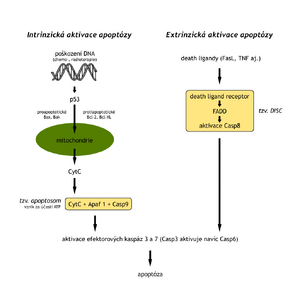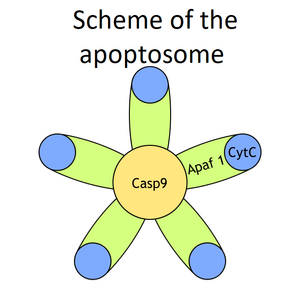Apoptosis signaling disorders in tumor cells
One of the basic functions of apoptosis is to prevent the malignant proliferation of tissues. Apoptosis is part of tissue homeostasis – the balanced formation and destruction of cells. Excessive apoptosis leads to tissue hypotrophy (e.g. in ischemia). Reduced death (as well as increased cell replication) leads to tumor transformation. All transformed cells had to suppress apoptosis during their transformation.
Apoptosis is triggered in two ways – intrinsic and extrinsic pathways. In some cells, both must be activated (especially the outer one, which subsequently activates the inner one), in others only the inner one is sufficient. Both pathways converge by activating the executive caspases 3, 7, and 6, and then apoptosis occurs.
Outer track[edit | edit source]
It begins with the binding of DR L (Death Receptor ligand) to the Death Receptor, i.e. Fas L to the Fas receptor and the subsequent trimerization of these receptors (the ligand is taken there either thanks to cell apoptosis triggering or apocrine secretion, apoptosis triggering factors also include cytokines, growth factors, hormones, toxins). Via the FADD protein, the initiator procaspase 8 or 10 homodimer binds to these receptors, which after DR activation is proteolytically activated into an active caspase homodimer. This whole complex is called DISC (Death inducing signaling complex). Caspase homodimer has 2 roles: activate executive procaspases 3, 7 and cleave Bid protein to t-Bid protein. Caspase 3 then cleaves procaspase 6. Caspases 3, 6, 7 are the executor proteases of apoptosis itself.
Inner track[edit | edit source]
Or mitochondrial. Thanks to the change in the permeability internal mitochodnrial membrane cytochrome c is released into the cytosol, where it binds to the inactive Apaf-1 protein and thus changes its conformation. After binding ATP the Apaf-1*cyt c*ATP complex assembles into a pentamer, which is able to bind procaspase 9, which after binding turns into active caspase 9. The whole complex complex is called an apoptosome. This apoptosome is able to convert procaspases 3, 7 into caspases 3, 7. The change in mitochondrial membrane permeability is regulated by the Bcl family of proteins. Proapoptotic Bax, Bak they form homodimers or heterodimers that mean the permeability of the inner mitochondrial membrane. However, this should be impermeable in a healthy cell, which is why there are anti-apoptotic proteins Bcl-, Bcl-xl, which together with Bak and Bax form Bax/Bcl-2 heterodimers and these are impermeable. Increased levels of Bcl-2 were first found in B-Cell Lymphoma.
The internal pathway is induced by lack of O2 and nutrients, viral infection, gkucocorticoids, heat, radiation (damage to DNA or mitochondria).
Signaling failures[edit | edit source]
Loss of activation signal[edit | edit source]
There can be either a reduction in DR expression, or non-functional ones, such as so-called decoy receptors, are synthesized. These lack the cytosolic DD domain, so FADD cannot bind and DISC activation is thus prevented.
Signal reshuffle[edit | edit source]
TRADD (Tumor necrosis factor Receptor Associated Death Domain) does not bind the required FADD (Fas Associated Death Domain), which is able to bind procaspase 8. Instead, TRADD binds to TRAF (TNF Receptor Associated Factor), which through a cascade of several kinases expresses the transcription factor NFkB . The effect of NFkB consists in the activation of antiapoptotic factors XIAP, FLIP and Bcl-2. There are assumptions that it negatively affects the course of apoptosis itself.
Inactivation of the DISC by FLIP proteins[edit | edit source]
The FLIP protein has a very similar structure to procaspase 8, it contains a DED domain , which binds to the FADD protein and takes the place of one or two procaspase 8 in the DISC. Thus, homodimers cannot form or be proteolytically activated. This inhibition is directly proportional to the FLIP protein concentration. There is no need to despair right away, even with insufficient activation of caspase 8, it can at least cleave proteins around the DISC, e.g. protein Bid. This then, as tBID, eliminates the Bcl-2 protein and thereby causes cytochrome to escape from the mitochondria.
Inhibitory Caspases[edit | edit source]
IAPs (Inhibitors of Apoptosis Proteins) prevent their activation to caspases by directly binding to the active sites of procaspase. They are, for example, HIAP, XIAP, SURVIVIN, LIVIN. Increased expression of SURVIVIN has been demonstrated in many tumor types.
Mitochondrial signaling disorders associated with the tumor suppressor p53[edit | edit source]
When DNA is damaged, transcription of the TP53 gene occurs , the product of which is the transcription factor p53. The p53 protein has a key role in suppressing tumor processes. Firstly, by expressing p21, GADD45 builds the cell cycle, secondly, by increasing the expression of Bax, PUMA and suppressing Bcl-2, it significantly helps to release cytochrome ca and other pro-apoptotic factors from mitochondria. (Altering the Bax/Bcl-2 ratio.) Another pro-apoptotic effect is the upregulation of FAS, DR5 or Apaf 1.
| Functions of pro-apoptotic factors released from mitochondria | |
|---|---|
| factor | function |
| Cytochrom c | activation of the apoptosome (see above) |
| SMAC/DIABLO | It represents another link between the extrinsic and intrinsic pathways by inactivating XIAP, which would like to inhibit caspase 3. This interaction is of great importance, as caspase 3 further cleaves XIAP through positive feedback. |
| Endonuclease G | cleaves DNA in caspase-independent apoptosis |
| HtrA2 | is the main IAP antagonist, preventing the inactivation of caspases |
| AIF | Apoptosis Inducing Factor acts during caspase-independent apoptosis, after release from mitochondria it induces chromatinu and fragmentation of the DNA. |
Other possibilities of influencing apoptosis[edit | edit source]
Point mutation of the Ras gene can lead to excessive activation of Akt kinase (via MAP kinases). This is generally associated with cell survival. It weakens the internal activation of apoptosis by phosphorylating caspase 9, phosphorylating Bad (phosphorylation of these proteins means inactivation). It also inactivates Fas L. It also positively affects NFkB through the IKK kinase.
Apoptosis signaling is a very complicated process regulated by many proteins. Fortunately, there are many "safeguards" that can jump in if the first one fails, whether it is internal and external activation and their interconnection or caspase-independent apoptosis. The tumor process is multiple and a single mutation is certainly not enough to suppress apoptosis. Nevertheless, one must keep in mind p53 and the Bcl family of proteins whose defects can be fatal from the point of view of oncogenesis.
Links[edit | edit source]
Related articles[edit | edit source]
Source[edit | edit source]
- VERMACH, Petr. Vypracované otázky ke zkoušce z patobiochemie. 2010.
Bibliography[edit | edit source]
- KALOUSOVÁ, Marta, et al. Patobiochemie ve schématech. 1. edition. Praha : GRADA, 2006. 200 pp. ISBN 978-80-247-3069-1.
- DVORSKÁ, M. Apoptóza v gynekologii a porodnictví : Část I, patofyziologie apoptózy [online]. Časopis ženských lékařů Gynekolog, ©2008. [cit. 2011-01-12]. <https://www.mf.cz/produkty/gynekolog-casopis-zenskych-lekaru/clanky/2008/408cl1.htm>.
- FULDA, Simone – KLAUS-MICHAEL, Debatin. Caspase Activation in Cancer Therapy : Pathways of Caspase Activation [online]. ©2010. [cit. 2011-01-12]. <https://www.ncbi.nlm.nih.gov/books/NBK6027/>.
- Wikipedia. Apoptosis [online]. [cit. 2010-11-21]. <https://en.wikipedia.org/w/index.php?title=Apoptosis&oldid=391050559>.
External links[edit | edit source]
- E-learningový materiál (pouze členové akademické obce 1. LF UK)


